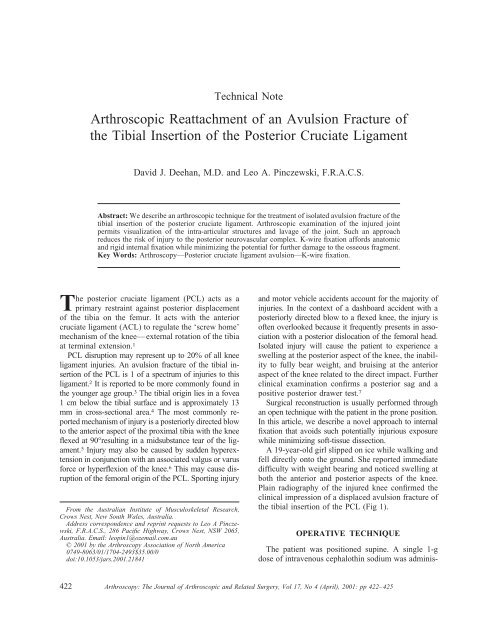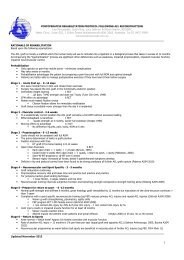Arthroscopic Reattachment of an Avulsion Fracture of the Tibial ...
Arthroscopic Reattachment of an Avulsion Fracture of the Tibial ...
Arthroscopic Reattachment of an Avulsion Fracture of the Tibial ...
Create successful ePaper yourself
Turn your PDF publications into a flip-book with our unique Google optimized e-Paper software.
Technical Note<br />
<strong>Arthroscopic</strong> <strong>Reattachment</strong> <strong>of</strong> <strong>an</strong> <strong>Avulsion</strong> <strong>Fracture</strong> <strong>of</strong><br />
<strong>the</strong> <strong>Tibial</strong> Insertion <strong>of</strong> <strong>the</strong> Posterior Cruciate Ligament<br />
David J. Deeh<strong>an</strong>, M.D. <strong>an</strong>d Leo A. Pinczewski, F.R.A.C.S.<br />
Abstract: We describe <strong>an</strong> arthroscopic technique for <strong>the</strong> treatment <strong>of</strong> isolated avulsion fracture <strong>of</strong> <strong>the</strong><br />
tibial insertion <strong>of</strong> <strong>the</strong> posterior cruciate ligament. <strong>Arthroscopic</strong> examination <strong>of</strong> <strong>the</strong> injured joint<br />
permits visualization <strong>of</strong> <strong>the</strong> intra-articular structures <strong>an</strong>d lavage <strong>of</strong> <strong>the</strong> joint. Such <strong>an</strong> approach<br />
reduces <strong>the</strong> risk <strong>of</strong> injury to <strong>the</strong> posterior neurovascular complex. K-wire fixation affords <strong>an</strong>atomic<br />
<strong>an</strong>d rigid internal fixation while minimizing <strong>the</strong> potential for fur<strong>the</strong>r damage to <strong>the</strong> osseous fragment.<br />
Key Words: Arthroscopy—Posterior cruciate ligament avulsion—K-wire fixation.<br />
The posterior cruciate ligament (PCL) acts as a<br />
primary restraint against posterior displacement<br />
<strong>of</strong> <strong>the</strong> tibia on <strong>the</strong> femur. It acts with <strong>the</strong> <strong>an</strong>terior<br />
cruciate ligament (ACL) to regulate <strong>the</strong> ‘screw home’<br />
mech<strong>an</strong>ism <strong>of</strong> <strong>the</strong> knee—external rotation <strong>of</strong> <strong>the</strong> tibia<br />
at terminal extension. 1<br />
PCL disruption may represent up to 20% <strong>of</strong> all knee<br />
ligament injuries. An avulsion fracture <strong>of</strong> <strong>the</strong> tibial insertion<br />
<strong>of</strong> <strong>the</strong> PCL is 1 <strong>of</strong> a spectrum <strong>of</strong> injuries to this<br />
ligament. 2 It is reported to be more commonly found in<br />
<strong>the</strong> younger age group. 3 The tibial origin lies in a fovea<br />
1 cm below <strong>the</strong> tibial surface <strong>an</strong>d is approximately 13<br />
mm in cross-sectional area. 4 The most commonly reported<br />
mech<strong>an</strong>ism <strong>of</strong> injury is a posteriorly directed blow<br />
to <strong>the</strong> <strong>an</strong>terior aspect <strong>of</strong> <strong>the</strong> proximal tibia with <strong>the</strong> knee<br />
flexed at 90°resulting in a midsubst<strong>an</strong>ce tear <strong>of</strong> <strong>the</strong> ligament.<br />
5 Injury may also be caused by sudden hyperextension<br />
in conjunction with <strong>an</strong> associated valgus or varus<br />
force or hyperflexion <strong>of</strong> <strong>the</strong> knee. 6 This may cause disruption<br />
<strong>of</strong> <strong>the</strong> femoral origin <strong>of</strong> <strong>the</strong> PCL. Sporting injury<br />
From <strong>the</strong> Australi<strong>an</strong> Institute <strong>of</strong> Musculoskeletal Research,<br />
Crows Nest, New South Wales, Australia.<br />
Address correspondence <strong>an</strong>d reprint requests to Leo A Pinczewski,<br />
F.R.A.C.S., 286 Pacific Highway, Crows Nest, NSW 2065,<br />
Australia. Email: leopin1@ozemail.com.au<br />
© 2001 by <strong>the</strong> Arthroscopy Association <strong>of</strong> North America<br />
0749-8063/01/1704-2493$35.00/0<br />
doi:10.1053/jars.2001.21841<br />
<strong>an</strong>d motor vehicle accidents account for <strong>the</strong> majority <strong>of</strong><br />
injuries. In <strong>the</strong> context <strong>of</strong> a dashboard accident with a<br />
posteriorly directed blow to a flexed knee, <strong>the</strong> injury is<br />
<strong>of</strong>ten overlooked because it frequently presents in association<br />
with a posterior dislocation <strong>of</strong> <strong>the</strong> femoral head.<br />
Isolated injury will cause <strong>the</strong> patient to experience a<br />
swelling at <strong>the</strong> posterior aspect <strong>of</strong> <strong>the</strong> knee, <strong>the</strong> inability<br />
to fully bear weight, <strong>an</strong>d bruising at <strong>the</strong> <strong>an</strong>terior<br />
aspect <strong>of</strong> <strong>the</strong> knee related to <strong>the</strong> direct impact. Fur<strong>the</strong>r<br />
clinical examination confirms a posterior sag <strong>an</strong>d a<br />
positive posterior drawer test. 7<br />
Surgical reconstruction is usually performed through<br />
<strong>an</strong> open technique with <strong>the</strong> patient in <strong>the</strong> prone position.<br />
In this article, we describe a novel approach to internal<br />
fixation that avoids such potentially injurious exposure<br />
while minimizing s<strong>of</strong>t-tissue dissection.<br />
A 19-year-old girl slipped on ice while walking <strong>an</strong>d<br />
fell directly onto <strong>the</strong> ground. She reported immediate<br />
difficulty with weight bearing <strong>an</strong>d noticed swelling at<br />
both <strong>the</strong> <strong>an</strong>terior <strong>an</strong>d posterior aspects <strong>of</strong> <strong>the</strong> knee.<br />
Plain radiography <strong>of</strong> <strong>the</strong> injured knee confirmed <strong>the</strong><br />
clinical impression <strong>of</strong> a displaced avulsion fracture <strong>of</strong><br />
<strong>the</strong> tibial insertion <strong>of</strong> <strong>the</strong> PCL (Fig 1).<br />
OPERATIVE TECHNIQUE<br />
The patient was positioned supine. A single 1-g<br />
dose <strong>of</strong> intravenous cephalothin sodium was adminis-<br />
422 Arthroscopy: The Journal <strong>of</strong> <strong>Arthroscopic</strong> <strong>an</strong>d Related Surgery, Vol 17, No 4 (April), 2001: pp 422–425
ARTHROSCOPIC REATTACHMENT OF PCL TIBIAL INSERTION<br />
423<br />
FIGURE 1. Lateral radiograph <strong>of</strong> flexed knee identifying avulsed<br />
distal insertion <strong>of</strong> PCL.<br />
tered before inflation <strong>of</strong> a high thigh tourniquet at 300<br />
mm Hg. Examination under <strong>an</strong>es<strong>the</strong>sia confirmed a<br />
posterior sag with a s<strong>of</strong>t end point. Midcentral <strong>an</strong>terolateral,<br />
midcentral <strong>an</strong>teromedial, posteromedial, <strong>an</strong>d<br />
posterolateral portals were used. A separate 1.5-cm<br />
longitudinal incision 1-cm medial to <strong>the</strong> tibial tuberosity<br />
was used for insertion <strong>of</strong> <strong>the</strong> 1.25-mm diameter<br />
K-wires in <strong>an</strong> <strong>an</strong>teroposterior direction with cephalic<br />
tilt.<br />
At arthroscopy, a fr<strong>an</strong>k hemarthrosis was drained.<br />
An osteochondral fracture <strong>of</strong> <strong>the</strong> posterior tibial plateau<br />
involving <strong>the</strong> insertion <strong>of</strong> <strong>the</strong> PCL was found.<br />
The ligament itself was uninvolved. Through <strong>the</strong> posteromedial<br />
portal, <strong>the</strong> PCL <strong>an</strong>d its attached fragment<br />
were pushed laterally into <strong>the</strong> joint. The s<strong>of</strong>t tissue <strong>an</strong>d<br />
hematoma about <strong>the</strong> c<strong>an</strong>cellous crater was removed<br />
using a 4.5-mm arthroscopic shaver (Smith & Nephew<br />
Dyonics, Andover MA). Three K-wires were passed<br />
percut<strong>an</strong>eously to <strong>the</strong> fragment crater <strong>of</strong> <strong>the</strong> tibia until<br />
<strong>the</strong>ir tips were visible. The fragment was <strong>the</strong>n reduced<br />
<strong>an</strong>d held. The K-wires were drilled through <strong>the</strong> fragment<br />
to beyond 1 cm under direct vision. A similar<br />
technique for <strong>an</strong> avulsion <strong>of</strong> <strong>the</strong> ACL is illustrated in<br />
Fig 2. The wires were turned into a U shape by<br />
grasping <strong>the</strong> free ends with a needle holder inserted<br />
through <strong>the</strong> posterolateral <strong>an</strong>d posteromedial portals.<br />
The K-wires were <strong>the</strong>n withdrawn <strong>an</strong>teriorly, thus<br />
capturing <strong>the</strong> fragment. The wires were bent 12° <strong>an</strong>teriorly<br />
<strong>an</strong>d held with a needle holder. By a series <strong>of</strong><br />
sharp blows directed away from <strong>the</strong> <strong>an</strong>terior tibial<br />
cortex, <strong>the</strong> posterior osseous fragment was impacted<br />
into <strong>the</strong> fovea <strong>an</strong>d <strong>an</strong>atomic reduction maintained. The<br />
wires were bent to <strong>an</strong> acute <strong>an</strong>gle to lie against <strong>the</strong><br />
<strong>an</strong>terior tibial cortex. The wires were trimmed so as to<br />
FIGURE 3. Postoperative <strong>an</strong>teroposterior radiograph confirming<br />
<strong>an</strong>atomic reduction.<br />
lie flush with <strong>the</strong> tibia subcut<strong>an</strong>eously. Hemostasis<br />
was secured after release <strong>of</strong> <strong>the</strong> tourniquet. Postoperative<br />
radiographs in both <strong>an</strong>teroposterior <strong>an</strong>d lateral<br />
views confirmed satisfactory positioning <strong>of</strong> <strong>the</strong> internal<br />
fixation (Figs 3 <strong>an</strong>d 4).<br />
Skin sutures were removed 1 week postoperatively.<br />
The patient was allowed to commence immediate<br />
quadriceps exercises <strong>an</strong>d remained partial weight<br />
FIGURE 2. Operative photograph showing K-wires capturing osseous<br />
fragment.
424 D. J. DEEHAN AND L. A. PINCZEWSKI<br />
bearing for 4 weeks. At 6 weeks, <strong>the</strong> K-wires were<br />
removed by opening <strong>the</strong> tibial incision <strong>an</strong>d withdrawing<br />
<strong>the</strong> wires by const<strong>an</strong>t force, straightening <strong>the</strong>m in<br />
<strong>the</strong> process <strong>of</strong> withdrawal. Examination under <strong>an</strong>es<strong>the</strong>sia<br />
confirmed a stable joint. The patient made <strong>an</strong><br />
uneventful recovery. At 2 years, she was asymptomatic<br />
<strong>an</strong>d had returned to competitive sport.<br />
DISCUSSION<br />
<strong>Avulsion</strong> fractures <strong>of</strong> <strong>the</strong> tibial insertion <strong>of</strong> <strong>the</strong> PCL<br />
represent a small subgroup <strong>of</strong> <strong>the</strong> spectrum <strong>of</strong> injuries<br />
to this ligament <strong>an</strong>d are believed to occur more frequently<br />
in <strong>the</strong> younger patient. 7 Most authors agree<br />
that acute surgical reconstruction is <strong>the</strong> treatment <strong>of</strong><br />
choice even for minimal displacement <strong>of</strong> <strong>the</strong> fragments.<br />
8 Conservative treatment, with distraction <strong>of</strong> <strong>the</strong><br />
fracture components, commonly results in nonunion<br />
<strong>an</strong>d may predispose to late functional instability <strong>of</strong> <strong>the</strong><br />
knee. 8<br />
FIGURE 4.<br />
reduction.<br />
Postoperative lateral radiograph confirming <strong>an</strong>atomic<br />
Surgical exposure to achieve open reduction <strong>an</strong>d<br />
internal fixation is most commonly performed through<br />
a posterior approach. 9 A lazy S incision centered on<br />
<strong>the</strong> popliteal fossa allows for direct visualization <strong>of</strong><br />
<strong>the</strong> neurovascular structures. A limited distal arthrotomy<br />
exposes <strong>the</strong> fracture <strong>an</strong>d allows for direct reattachment<br />
<strong>of</strong> <strong>the</strong> avulsed component. However, such<br />
surgical exposure is not without risk. The complex<br />
<strong>an</strong>atomy in <strong>the</strong> popliteal fossa is at risk <strong>of</strong> direct injury<br />
during dissection. Postoperative swelling as a result <strong>of</strong><br />
tissue edema or from venous bleeding may generate<br />
increased interstitial pressure with <strong>the</strong> development <strong>of</strong><br />
a compartment syndrome. Retraction <strong>of</strong> <strong>the</strong> s<strong>of</strong>t tissues<br />
at surgery may inadvertently lead to a traction<br />
neurapraxia <strong>of</strong> <strong>the</strong> common peroneal nerve. <strong>Arthroscopic</strong><br />
reattachment <strong>of</strong> <strong>the</strong> fracture avoids such posterior<br />
s<strong>of</strong>t-tissue dissection <strong>an</strong>d thus minimizes <strong>the</strong><br />
risk <strong>of</strong> injury to <strong>the</strong> posterior structures. Direct visualization<br />
<strong>of</strong> <strong>the</strong> tibial insertion bed <strong>an</strong>d docking <strong>of</strong> <strong>the</strong><br />
avulsed fragment may be achieved with <strong>the</strong> use <strong>of</strong><br />
arthroscopic portal placement.<br />
An avulsion fracture <strong>of</strong> <strong>the</strong> PCL may not be <strong>an</strong><br />
isolated finding. Femoral <strong>an</strong>d patellar chondral defects,<br />
<strong>an</strong>d concomit<strong>an</strong>t tears <strong>of</strong> <strong>the</strong> ACL <strong>an</strong>d menisci<br />
have been found in association with tears <strong>of</strong> <strong>the</strong><br />
PCL. 10,11 <strong>Arthroscopic</strong> repair, unlike <strong>the</strong> open posterior<br />
approach, permits full exploration <strong>of</strong> <strong>the</strong> knee<br />
joint, fulfilling <strong>the</strong> principle <strong>of</strong> thorough joint examination<br />
at <strong>the</strong> time <strong>of</strong> surgery for a ligament injury.<br />
<strong>Reattachment</strong> <strong>of</strong> <strong>the</strong> avulsed segment may be performed<br />
using a screw, 1 or more K-wires, wire suture,<br />
or staple. 8,12-18 Previous work has confirmed excellent<br />
results with <strong>an</strong>y <strong>of</strong> <strong>the</strong>se methods. We have identified<br />
2 published case reports <strong>of</strong> <strong>an</strong> arthroscopic approach<br />
for this injury. 19,20 In both cases, lag screw fixation<br />
was used. However, a precondition <strong>of</strong> this technique is<br />
<strong>the</strong> presence <strong>of</strong> a sufficiently large avulsed fragment<br />
so as to enable adequate screw purchase <strong>an</strong>d fragment<br />
capture. No such precondition is necessary with <strong>the</strong><br />
described technique. We used K-wire fixation because<br />
it provides secure fixation with minimal risk <strong>of</strong> damage<br />
to <strong>the</strong> avulsed osseous fragment. The wires were<br />
sequentially bent over <strong>the</strong>mselves to form a U shape<br />
<strong>an</strong>d were pulled forward. A fur<strong>the</strong>r bend <strong>an</strong>teriorly<br />
over <strong>the</strong> tibial cortex prevented subsequent migration<br />
<strong>of</strong> <strong>the</strong> wires. Lee 15 has proposed augmenting surgical<br />
fixation with plication <strong>of</strong> <strong>the</strong> PCL to <strong>the</strong> capsular<br />
tissue. We do not feel that this is necessary since our<br />
patient was mobilized immediately without subsequent<br />
damage to <strong>the</strong> ligament.<br />
We consider this technique to be <strong>an</strong> effective<br />
method <strong>of</strong> reduction <strong>an</strong>d fixation for this fracture
ARTHROSCOPIC REATTACHMENT OF PCL TIBIAL INSERTION<br />
425<br />
pattern. It has been used successfully in a fur<strong>the</strong>r 6<br />
cases. Avoiding dissection <strong>of</strong> <strong>the</strong> posterior s<strong>of</strong>t tissue<br />
subst<strong>an</strong>tially minimizes <strong>the</strong> risk <strong>of</strong> damage to <strong>the</strong><br />
neurovascular structures, as c<strong>an</strong> happen in open surgery,<br />
<strong>an</strong>d eliminates potential morbidity from a posterior<br />
knee wound.<br />
REFERENCES<br />
1. Detenbeck LC. Function <strong>of</strong> <strong>the</strong> cruciate ligaments in knee<br />
stability. Am J Sports Med 1974;2:217-221.<br />
2. Clendenin MB, DeLee JC, Heckm<strong>an</strong> JD. Interstitial tears <strong>of</strong><br />
<strong>the</strong> posterior cruciate ligament <strong>of</strong> <strong>the</strong> knee. Orthopedics 1980;<br />
3:764-772.<br />
3. S<strong>an</strong>ders WE, Wilkens KE, Neidre A. Acute insufficiency <strong>of</strong><br />
<strong>the</strong> posterior cruciate ligament in children. J Bone Joint Surg<br />
Am 1980;62:129-131.<br />
4. Girgis FG, Marshall JL, Al Monarem ARS. The cruciate<br />
ligaments <strong>of</strong> <strong>the</strong> knee joint. Anatomical, functional <strong>an</strong>d experimental<br />
<strong>an</strong>alysis. Clin Orthop 1975;106:216-231.<br />
5. Lipscomb AAB, Anderson AF, Norwig ED, Hovis WD,<br />
Brown DL. Isolated posterior cruciate ligament reconstruction.<br />
Long-term results. Am J Sports Med 1993;21:490-496.<br />
6. Fowler PJ, Messieh SS. Isolated posterior cruciate ligament<br />
injuries in athletes. Am J Sports Med 1987;15:553-557.<br />
7. Trickey EL. Injuries to <strong>the</strong> posterior cruciate ligament. Diagnosis<br />
<strong>an</strong>d treatment <strong>of</strong> early injuries <strong>an</strong>d reconstructions <strong>of</strong> late<br />
instability. Clin Orthop 1980;147:76-81.<br />
8. Meyers MH. Isolated avulsion <strong>of</strong> <strong>the</strong> tibial attachment <strong>of</strong> <strong>the</strong><br />
posterior cruciate ligament <strong>of</strong> <strong>the</strong> knee. J Bone Joint Surg Am<br />
1975;57:669-672.<br />
9. Abbott LC, Saunders JBD, Bosh FC, Anderson CE. Injuries to<br />
<strong>the</strong> ligaments <strong>of</strong> <strong>the</strong> knee joint. J Bone Joint Surg Am 1944;<br />
16:503-521.<br />
10. Geissler WB, Whipple TL. Intraarticular abnormalities in association<br />
with posterior cruciate ligament injuries. Am J Sports<br />
Med 1993;21:846-849.<br />
11. Bi<strong>an</strong>chi M. Acute tears <strong>of</strong> <strong>the</strong> posterior cruciate ligament:<br />
Clinical study <strong>an</strong>d results <strong>of</strong> operative treatment in 27 cases.<br />
Am J Sports Med 1983;11:308-314.<br />
12. Brenn<strong>an</strong> JJ. <strong>Avulsion</strong> injuries <strong>of</strong> <strong>the</strong> posterior cruciate ligaments.<br />
Clin Orthop 1960;18:157-162.<br />
13. Burks RT, Schaffer JJ. A simplified approach to <strong>the</strong> tibial<br />
attachment <strong>of</strong> <strong>the</strong> posterior cruciate ligament. Clin Orthop<br />
1990;254:216-219.<br />
14. Galle P. Reconstruction <strong>of</strong> osseous rupture <strong>of</strong> <strong>the</strong> posterior<br />
cruciate ligament. Arch Orthop Trauma Surg 1979;95:241-<br />
243.<br />
15. Lee HG. <strong>Avulsion</strong> fracture <strong>of</strong> <strong>the</strong> tibial attachments <strong>of</strong> <strong>the</strong><br />
cruciate ligaments. Treatment by operative reduction. J Bone<br />
Joint Surg Am 1937;19:460-468.<br />
16. Shelbourne KD, Klootwyk TE, Wilckens JH, De Carlo MS.<br />
Ligament stability two to six years after <strong>an</strong>terior cruciate<br />
ligament reconstruction with autologous patellar tendon graft<br />
<strong>an</strong>d participation in accelerated rehabilitation program. Am J<br />
Sports Med 1995;23:575-579.<br />
17. Seitz H, Schlenz I, Pajenda G, Vecsei V. <strong>Tibial</strong> avulsion<br />
fracture <strong>of</strong> <strong>the</strong> posterior cruciate ligament: K-wire or screw<br />
fixation? A retrospective study <strong>of</strong> 26 patients. Arch Orthop<br />
Trauma Surg 1997;116:275-278.<br />
18. Torisu T. <strong>Avulsion</strong> fracture <strong>of</strong> <strong>the</strong> tibial attachment <strong>of</strong> <strong>the</strong><br />
posterior cruciate ligament: Indications <strong>an</strong>d results <strong>of</strong> delayed<br />
repairs. Clin Orthop 1979;143:107-114.<br />
19. Choi N-H, Kim S-J. <strong>Arthroscopic</strong> reduction <strong>an</strong>d fixation <strong>of</strong><br />
bony avulsion <strong>of</strong> <strong>the</strong> posterior cruciate ligament <strong>of</strong> <strong>the</strong> tibia.<br />
Arthroscopy 1997;13:759-762.<br />
20. Littlejohn SG, Geissler WB. <strong>Arthroscopic</strong> repair <strong>of</strong> a posterior<br />
cruciate ligament avulsion. Arthroscopy 1995;11:235-238.




